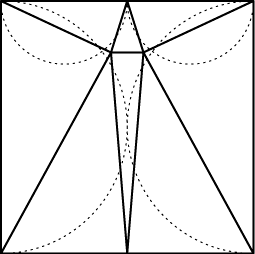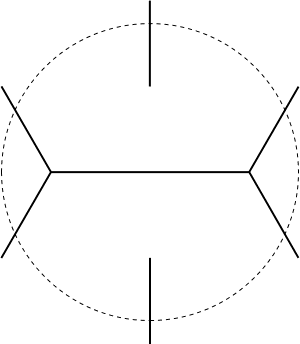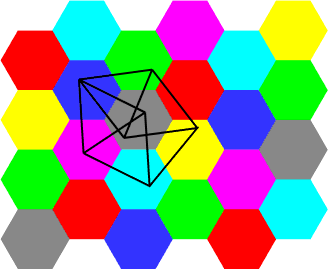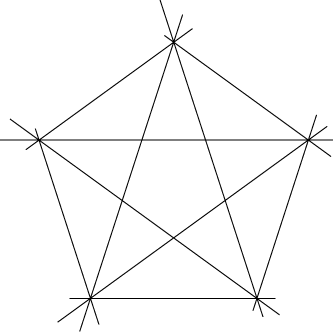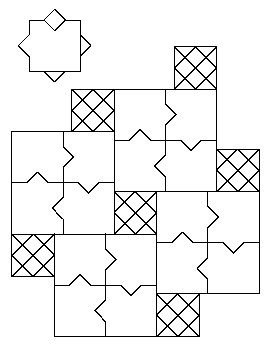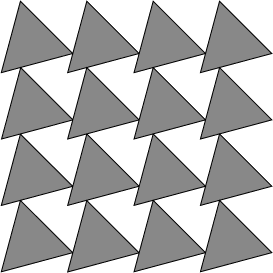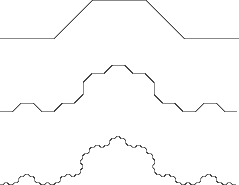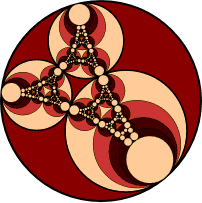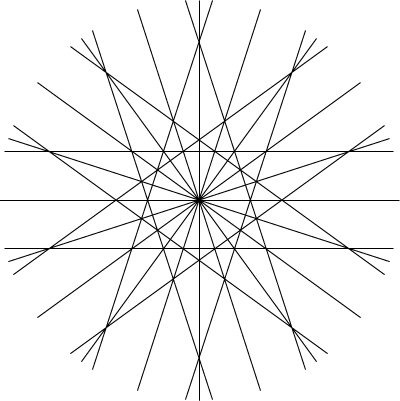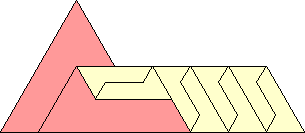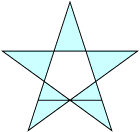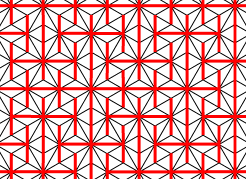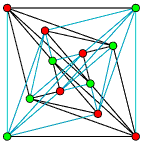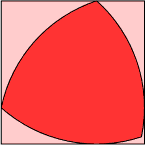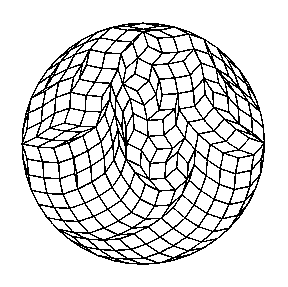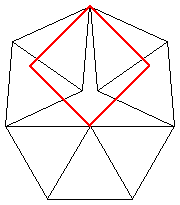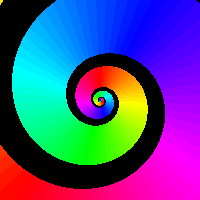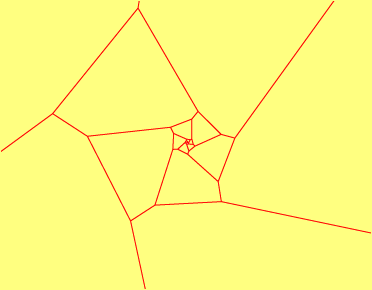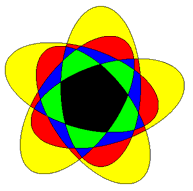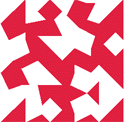
Planar Geometry
- Acute square triangulation.
Can one partition the square into triangles with all angles acute?
How many triangles are needed, and what is the best angle bound possible?
- Adventitious geometry.
Quadrilaterals in which the sides and diagonals form
more rational angles with each other than one might expect.
Dave Rusin's known math pages include
another article on the same problem.
- 1st
and 2nd Ajima-Malfatti points. How to pack three circles in a
triangle so they each touch the other two and two triangle sides. This
problem has a curious history, described in Wells' Penguin Dictionary
of Curious and Interesting Geometry: Malfatti's original (1803)
question was to carve three columns out of a prism-shaped block of
marble with as little wasted stone as possible, but it wasn't until 1967
that it was shown that these three mutually tangent circles are never
the right answer.
See also
this Cabri geometry page,
the MathWorld
Malfatti circles page, and the Wikipedia
Malfatti circles page.
- Are all triangles
isosceles?
A fallacious proof from K. S. Brown's math pages.
- Ancient
Islamic Penrose Tiles. Peter Lu uncovers evidence that the
architects of a 500-year-old Iranian shrine used Penrose tiling to lay
out the decorative patterns on its archways. From Ivars Peterson's
MathTrek.
- Angle
trisection, from the geometry forum archives.
- Animated proof
of the Pythagorean theorem, M. D. Meyerson, US Naval Academy.
- Aperiodic
colored tilings, F. Gähler.
Also
available in postscript.
- Aperiodic
tiling and Penrose tiles, Steve Edwards.
- Apollonian Gasket,
a fractal circle packing formed by packing smaller circles into each
triangular gap formed by three larger circles.
From MathWorld.
- Applications of shapes of constant width.
A Reuleaux triangle doesn't quite drill out a square hole (it leaves
rounded corners) but a different and less-symmetric constant-width shape
based on an isosceles right triangle can be used to do so. This web page
also discusses coin design, cams, and rotary engines, all based on
curves of constant width; see
also discussion
on Metafilter.
- Arc
length surprise. The sum of the areas of the regions between a
circular arc and the x-axis, and between the arc and the y-axis,
does not depend on the position of the arc!
From Mudd Math Fun Facts.
- Area of the Mandelbrot set.
One can upper bound this area by filling the area around the set by disks,
or lower bound it by counting pixels; strangely, Stan Isaacs notes,
these two methods do not seem to give the same answer.
- On the average height of jute crops in the
month of September. Vijay Raghavan points out an obscure reference
to average case analysis of the Euclidean traveling salesman problem.
- David Bailey's
world of tesselations.
Primarily consists of Escher-like drawings but also includes
an interesting section about Kepler's work on polyhedra.
- Balanced ternary
reptiles, Cantor's
hourglass reptile, spiral
reptile, stretchtiles,
trisection of India, the
three Bodhi problem,
and other Fractal tilings by
R. W. Gosper.
- Belousov's Brew.
A recipe for making spiraling patterns in chemical reactions.
- BitArt spirolateral
gallery (requires JavaScript to view large images, and Java to view
self-running demo or construct new spirolaterals).
- Brahmagupta's formula.
A "Heron-type" formula for the maximum area of a quadrilateral,
Col. Sicherman's fave. He asks if it has higher-dimensional
generalizations.
- Buffon's needle.
What is the probability that a dropped needle lands on a crack on a
hardwood floor?
From Kunkel's mathematics
lessons.
- Building a better beam detector.
This is a set that intersects all lines through the unit disk.
The construction below achieves
total length approximately 5.1547, but better bounds were previously known.
- Carnival triangles.
A factoid about similar triangles inspired by a trigonometric identity.
- Centers of maximum matchings.
Andy Fingerhut asks, given a maximum (not minimum) matching of six
points in the Euclidean plane, whether there is a center point
close to all matched edges (within distance a constant times the length
of the edge). If so, it could be extended to more points via Helly's theorem.
Apparently this is related to communication network design.
I include a response I sent with a proof (of a constant worse than the
one he wanted, but generalizing as well to bipartite matching).
- Chaotic tiling
of two kinds of equilateral pentagon, with
30degree symmetry, Ed Pegg Jr.
- The chromatic number of the plane.
Gordon Royle and Ilan Vardi summarize what's known about
the famous open problem of how many colors are needed to color
the plane so that no two points at a unit distance apart get the same color.
See also
another article from Dave Rusin's known math pages.
- Circle
packing and discrete complex analysis. Research by
Ken Stephenson including pictures, a bibliography, and downloadable circle packing
software.
- Circle packings.
Gareth McCaughan describes the connection between collections
of tangent circles and conformal mapping. Includes some pretty postscript
packing pictures.
- Circles in ellipses.
James Buddenhagen asks for the smallest ellipse that contains two
disjoint unit circles.
Discussion continued in a thread on
three
circles in an ellipse.
- Circular
coverage constants. How big must N equal disks be in order to
completely cover the unit disk? What about disks with sizes in
geometric progression? From MathSoft's favorite constants pages.
- Circular quadrilaterals.
Bill Taylor notes that if one connects the opposite midpoints
of a partition of the circle into four chords, the two line segments
you get are at right angles. Geoff Bailey supplies an elegant proof.
- Circumcenters of triangles.
Joe O'Rourke, Dave Watson, and William Flis
compare formulas for computing
the coordinates of a circle's center from three boundary points,
and higher dimensional generalizations.
- Circumference/perimeter
of an ellipse: formula(s). Interesting and detailed survey of
formulas giving accurate approximations to this value, which can not be
expressed exactly as a closed form formula.
- Coloring line arrangements. The graphs
formed by overlaying a collection of lines require three, four, or five colors,
depending on whether one allows three or more lines to meet at a point,
and whether the lines are considered to wrap around through infinity.
Stan Wagon
asks similar questions for unit circle arrangements.
- Complex
regular tesselations on the Euclid plane, Hironori Sakamoto.
- a
computational approach to tilings. Daniel Huson investigates the
combinatorics of periodic tilings in two and three dimensions, including
a classification of the tilings by shapes topologically equivalent to
the five Platonic solids.
- Contour
plots with trig functions.
Eric Weeks discovers a method of making interesting non-moiré patterns.
- Cool math: tessellations
- Covering points by rectangles.
Stan Shebs discusses the problem of finding a minimum number of
copies of a given rectangle that will cover all points in some set,
and mentions an application to a computer strategy game.
This is NP-hard, but I don't know how easy it is to approximate;
most related work I know of is on optimizing the rectangle size for a cover
by a fixed number of rectangles.
- The
Curlicue Fractal, Fergus C. Murray.
- Curvature of crossing convex curves.
Oded Schramm considers two smooth convex planar curves crossing at at
least three points, and claims that the minimum curvature of one is at
most the maximum curvature of the other. Apparently this is related
to conformal mapping. He asks for prior appearances of this problem
in the literature.
- Delaunay and regular triangulations.
Lecture by Herbert Edelsbrunner, transcribed by Pedro Ramos and Saugata
Basu. The regular triangulation has been popularized by Herbert as the
appropriate generalization of the Delaunay triangulation to collections
of disks.
- Delaunay triangulation and points of
intersection of lines. Tom McGlynn asks whether the DT of a line
arrangement's vertices must respect the lines; H. K. Ruud shows that the
answer is no.
- Dilation-free planar graphs.
How can you arrange n points so that the set of all lines between them
forms a planar graph with no extra vertices?
- Disjoint
triangles. Any 3n points in the plane can be partitioned into n
disjoint triangles. A. Bogomolny gives a simple proof and discusses
some generalizations.
- Dissection challenges.
Joshua Bao asks for some dissections of squares into other figures.
- Dissection and dissection tiling.
This page describes problems of partitioning polygons
into pieces that can be rearranged to tile the plane.
(With references to publications on dissection.)
- Dissection
problem-of-the-month from the Geometry Forum.
Cut squares and equilateral triangles into pieces and rearrange them to
form each other or smaller copies of themselves.
- Distinct point set with the same distance multiset.
From K. S. Brown's Math Pages.
- DUST
software for visualization of Voronoi diagrams, Delaunay triangulations,
minimum spanning trees, and matchings, U. Köln.
- Dynamic
formation of Poisson-Voronoi tiles. David Griffeath constructs
Voronoi diagrams using cellular automata.
- The Dynamic Systems
and Technology Project at Boston Univ. offers several Java applets
and animations of fractals and iterated function systems.
- An
eight-point arrangement in which each perpendicular bisector passes
through two other points.
From Stan Wagon's
PotW archive.
- Ellipse
game, or whack-a-focus.
- Elliptical
billiard tables, H. Serras, Ghent.
- Enumeration of
polygon triangulations and other combinatorial representations of
the Catalan numbers.
- Equiangular
spiral. Properties of Bernoulli's logarithmic 'spiralis mirabilis'.
- An
equilateral dillemma. IBM asks you to prove that the only triangles
that can be circumscribed around an equilateral triangle, with their
vertices equidistant from the equilateral vertices, are themselves equilateral.
- Equilateral
pentagons. Jorge Luis Mireles Jasso investigates these polygons
and dissects various polyominos into them.
- Equilateral
pentagons that tile the plane, Livio Zucca.
- Equilateral
triangles. Dan Asimov asks how large a triangle will fit into a
square torus; equivalently, the densest packing of equilateral triangles
in the pattern of a square lattice.
There is only one parameter to optimize, the angle of the triangle to
the lattice vectors; my answer
is that the densest packing occurs when
this angle is 15 or 45 degrees, shown below.
(If the lattice doesn't have to be square, it is possible to get density
2/3; apparently this was long known, e.g. see Fáry,
Bull. Soc. Math. France 78 (1950) 152.)
Asimov also asks for the smallest triangle that will always cover at least
one point of the integer lattice, or equivalently a triangle
such that no matter at what angle you place copies of it on an integer lattice,
they always cover the plane; my guess is that the worst angle is parallel
and 30 degrees to the lattice, giving a triangle with 2-unit sides
and contradicting an earlier answer to Asimov's question.
- Equivalents of the parallel postulate.
David Wilson quotes a book by George Martin, listing 26 axioms
equivalent to Euclid's parallel postulate.
See also Scott Brodie's proof of equivalence with the Pythagorean theorem.
- Erich's
Packing Page. Erich Friedman enjoys packing geometric shapes into
other geometric shapes.
- An
extension of Napoleon's theorem. Placing similar isosceles
triangles on the sides of an affine-transformed regular polygon results
in a figure where the triangle vertices lie on another regular polygon.
Geometer's sketchpad animation by John Berglund.
- Fagnano's
problem of inscribing a minimum-perimeter triangle within another
triangle, animated in Java by A. Bogomolny.
See also part II, part III,
and a reversed version.
- Fagnano's theorem.
This involves differences of lengths in an ellipse.
Joe Keane asks why it is unusual.
- Famous curve applet index.
Over fifty well-known plane curves, animated as Java applets.
- Fermat's spiral and the line between Yin and Yang.
Taras Banakh, Oleg Verbitsky, and Yaroslav Vorobets argue that the ideal
shape of the dividing line in a Yin-Yang symbol is formed, not from two
semicircles, but
from Fermat's
spiral.
- Finding
the wood by the trees. Marc van Kreveld studies strategies by which
a blind man with a rope could map out a forest.
- Five circle theorem.
Karl Rubin and Noam Elkies asked for a proof that a certain construction
leads to five cocircular points. This result was subsequently discovered
by Allan Adler and Gerald Edgar to be essentially the same as a theorem
proven in 1939 by F. Bath.
- Flatland:
A Romance of Many Dimensions.
- The
Four Color Theorem.
A new proof by Robertson, Sanders, Seymour, and Thomas.
- Fractal bacteria.
- A fractal beta-skeleton with high dilation.
Beta-skeletons are graphs used, among other applications, in predicting
which pairs of cities should be connected by roads in a road network.
But if you build your road network this way, it may take you a long time
to get from point a to point b.
- Fractal instances of the traveling salesman problem, P. Moscato, Buenos Aires.
- Fractal knots, Robert Fathauer.
- Fractal patterns formed by repeated inversion of circles:
Indra's Pearls
Inversion graphics gallery, Xah Lee.
Inversive circles, W. Gilbert, Waterloo.
- Erich Friedman's dissection puzzle.
Partition a 21x42x42 isosceles triangles into six smaller triangles,
all similar to the original but with no two equal sizes.
(The link is to a drawing of the solution.)
- Gauss' tomb. The story that he asked
for (and failed to get) a regular 17-gon carved on it leads to some
discussion of 17-gon construction and perfectly scalene triangles.
- Gaussian
continued fractions.
Stephen Fortescue discusses some connections between basic
number-theoretic algorithms and the geometry of tilings
of 2d and 3d hyperbolic spaces.
- Generating
Fractals from Voronoi Diagrams, Ken Shirriff, Berkeley and Sun.
- Geometric
Dissections by Gavin Theobald.
- Geometry,
algebra, and the analysis of polygons. Notes by M. Brundage on a
talk by B. Grünbaum on vector spaces formed by planar
n-gons under componentwise addition.
- Geometry
corner with Martin Gardner.
He describes some problems of cutting polygons into similar and
congruent parts. From the
MAT 007 I News.
- Ghost
diagrams, Paul Harrison's software for finding tilings with
Wang-tile-like hexagonal tiles, specified by matching rules on their
edges. These systems are Turing-complete, so capable of forming all
sorts of complex patterns; the web site shows binary circuitry, fractals,
1d cellular automaton simulation, Feynman diagrams, and more.
- Graham's hexagon, maximizing the ratio of area to diameter.
You'd expect it to be a regular hexagon, right? Wrong.
From MathSoft's favorite constants pages.
See also
Wolfgang
Schildbach's java animation of this hexagon and similar n-gons for larger values of n.
- Greg's
favorite math party trick. A nice visual proof of van Aubel's
theorem, that equal perpendicular line segments connect the opposite
centers of squares exterior to the sides of any quadrilateral.
See also Wikipedia,
MathWorld,
Geometry from
the land of the Incas,
interactive
Java applet.
- Heilbronn
triangle constants. How can you place n points in a square
so that all triangles formed by triples of points have large area?
- Hero's
Formula for the area of a triangle in terms of its side lengths.
Mark Dominus explains.
- How many intersection points
can you form from an n-line arrangement?
Equivalently, how many opposite pairs of faces can an n-zone
zonohedron have?
It must be a number between n-1 and n(n-1)/2,
but not all of those values are possible.
- How many
points can one find in three-dimensional space so that all triangles
are equilateral or isosceles?
One eight-point solution is formed by placing three points
on the axis of a regular pentagon.
This problem seems related to the fact that
any planar point set forms O(n7/3)
isosceles triangles; in three dimensions, Theta(n3) are possible
(by generalizing the pentagon solution above). From Stan Wagon's
PotW archive.
- How to construct a golden rectangle, K. Wiedman.
- Hyperbolic
games. Freeware multiplatform software for games such as Sudoku on
hyperbolic surfaces, intended as a way for students to gain familiarity
with hyperbolic geometry. By Jeff Weeks.
- In
plane sight. Equilateral triangle visibility problem from Andy
Drucker. See also
here.
- Infect.
Eric Weeks generates interesting colorings of aperiodic tilings.
- Infinite
families of simplicial arrangements.
- Integer distances.
Robert Israel gives a nice proof (originally due to Erdös) of the
fact that,
in any non-colinear planar point set in which all distances
are integers, there are only finitely many points.
Infinite sets of points with rational distances are known,
from which arbitrarily large finite sets of points with integer
distances can be constructed; however it is open whether there are even
seven points at integer distances in general position
(no three in a line and no four on a circle).
- Interactive Delaunay triangulation and Voronoi diagrams:
VoroGlide, Icking, Klein, Köllner, Ma, Hagen.
D. Watson, CSIRO, Australia.
Baker et al., Brown U.
Paul Chew, Cornell U.
- Interconnection Trees. Java minimum spanning tree implementation, Joe Ganley, Virginia.
- Inversive geometry. Geometric transformations of circles, animated with CabriJava.
- Irreptiles.
Karl Scherer and Erich Friedman generalize the concept of a reptile
(tiling of a shape
by smaller copies of itself) to allow the copies to have different scales.
See also
Karl Scherer's two-part irreptile puzzle.
- Islamic
geometric art.
- Isoperimetric
polygons. Livio Zucca groups grid polygons by their perimeter
instead of by their area. For small integer perimeter the results are
just polyominos but after that it gets more complicated...
- The isoperimetric problem for pinwheel tilings.
In these aperiodic tilings (generated by a substitution system involving
similar triangles) vertices are connected by paths almost as good
as the Euclidean straight-line distance.
- Isosceles
pairs. Stan Wagon asks which triangles can be dissected into
two isosceles triangles.
- Isotiles,
workbook on the shapes that can be formed by combining isosceles
triangles with side lengths in the golden ratio.
- Japanese Triangulation Theorem. The sum of inradii in a triangulation of a
cyclic polygon doesn't depend on which triangulation you choose!
Conversely, any polygon for which this is true is cyclic.
- Jiang Zhe-Ming's
geometry challenge. A pretty problem involving cocircularity of five
points defined by circles around a pentagram.
- Jordan sorting. This is the problem of
sorting (by x-coordinate) the intersections of a line with a simple
polygon. Complicated linear time algorithms for this are known (for
instance one can triangulate the polygon then walk from triangle to
triangle); Paul Callahan discusses an alternate algorithm based on the
dynamic optimality conjecture for splay trees.
- Kabon Triangles. How many disjoint triangles can you make out of n line segments? From Eric Weisstein's treasure trove of mathematics.
According to Toshi Kato, these should actually be called Kobon
triangles, after Kobon Fujimura in Japan;
Kato also tells me that Mr. Saburo Tamura proved a bound of
F(n) <n(n-2)/3.
- The
Kakeya-Besicovitch problem.
Paul Wellin describes this famous
problem of rotating a needle in a planar set of minimal area. As it
turns out the area can be made arbitrarily close to zero. See also
Steven Finch's
page on Kakeya-Besicovitch constants, and
Eric
Weisstein's page on the Kakeya Needle Problem.
- Kaleidoscope
geometry, Ephraim Fithian.
- Kaleidotile
software for visualizing tilings of the sphere, Euclidean plane, and
hyperbolic plane.
- Kali,
software for making symmetrical drawings based on any of the 17 plane
tiling groups.
- kD-tree
demo. Java applet by Jacob Marner.
- Richard
Kenyon's Gallery of tilings by squares and equilateral triangles of
varying sizes.
- The
Kneser-Poulsen Conjecture.
Bezdek and Connelly solve an old problem about pushing disks together.
- Labyrinth tiling.
This aperiodic substitution tiling by equilateral and isosceles triangles
forms fractal space-filling labyrinths.
- Largest
5-gon in a square, or more interestingly smallest equilateral
pentagon inscribed in a square.
Posting to sci.math by Rainer Rosenthal.
- Layered graph drawing.
- Lego sextic.
Clive Tooth draws infinity symbols using lego linkages,
and analyzes the resulting algebraic variety.
- Lenses,
rational-angled equilateral hexagons can tile the plane in various
interesting patterns. See also Jorge Mireles' nice
lens
puzzle applet: rotate decagons and stars to get the pieces into the
right places.
- LightSource
sacred geometry software.
- Line
designs for the computer. Jill Britton brings to the web material
from John Millington's 1989 book on geometric patterns formed by
stitching yarn through cardboard. The Java simulation of a Spectrum
computer running Basic programs is a little (ok a lot) clunky, and froze
Mozilla when I tried it, but there's also plenty of interesting static content.
- Log-spiral tiling,
and other radial
and spiral tilings, S. Dutch.
- Looking at
sunflowers. In this abstract of an undergraduate research paper,
Surat Intasang investigates the spiral patterns formed by sunflower seeds,
and discovers that often four sets of spirals can be discerned,
rather than the two sets one normally notices.
- A map of all
triangles and the search for the ideal acute scalene triangle, Robert Simms.
- The Margulis Napkin Problem.
Jim Propp asked for a proof that the perimeter of a flat origami
figure must be at most that of the original starting square.
Gregory Sorkin provides a simple example showing that on the contrary,
the perimeter can be arbitrarily large.
- Marius
Fine Art Studio Sacred Geometry Art.
Prints and paintings for sale of various geometric designs.
- Match
sticks in the summer. Ivars Peterson discusses the graphs
that can be formed by connecting vertices by non-crossing equal-length
line segments.
- Midpoint
triangle porism.
Two nested circles define a continuous family of triangles having endpoints
on the outer circle and edge midpoints on the inner circle.
A similar
porism works for quadrilaterals and, seemingly,
higher
order polygons.
Geometer's sketchpad animations by John Berglund.
- Minimize
the slopes. How few different slopes can be formed by the lines
connecting 881 points?
From Stan Wagon's
PotW archive.
- Miquel's
pentagram theorem on circles associated with a pentagon.
With annoying music.
- Mirrored room illumination.
A summary by Christine Piatko of the old open problem of, given
a polygon in which all sides are perfect mirrors, and a point source
of light, whether the entire polygon will be lit up.
The answer is no if smooth curves are allowed.
See also Eric Weisstein's page on the
Illumination
Problem.
- Moebius
transformations revealed. Video by Douglas N. Arnold and Jonathan
Rogness explaining 2d Moebius transformations in terms of the motions of
a 3d sphere. See also MathTrek.
- Monge's
theorem and Desargues' theorem, identified.
Thomas Banchoff relates these two results,
on colinearity of intersections of external tangents to disjoint circles,
and of intersections of sides of perspective triangles, respectively.
He also describes generalizations to higher dimensional spheres.
- Moser's Worm.
What is the smallest area shape (in a given class of shapes) that
can cover any unit-length path?
Part of Mathsoft's
collection of
mathematical constants.
- Natural neighbors.
Dave Watson supplies instances where shapes from
nature are (almost) Voronoi polygons. He also has a page
of related references.
- The
no-three-in-line problem.
How many points can be placed in an n*n grid with no three
on a common line? The solution is known to be between 1.5n and
2n. Achim Flammenkamp discusses some new computational results
including bounds on the number of symmetric solutions.
- Non-Euclidean
geometry with LOGO. A project at Cardiff, Wales, for using the LOGO
programming language to help mathematics students visualise
non-Euclidean geometry.
- Occurrence of
the conics.
Jill Britton explains how the different conic curves can all be formed
by slicing the same cone at different angles, and finds many examples of
them in technology and nature.
- Origami: a study in symmetry. M. Johnson and B. Beug, Capital H.S.
- Packing
circles in circles and circles on a sphere,
Jim Buddenhagen.
Mostly about optimal packing but includes also some nonoptimal spiral
and pinwheel packings.
- Packing
pennies in the plane, an illustrated proof of Kepler's conjecture in
2D by Bill Casselman.
- Packing
results, D. Boll. C code for finding dense packings of circles in
circles, circles in squares, and spheres in spheres.
- Packomania!
- A
pair of triangle centers, Vincent Goffin.
Do these really count as centers? They are invariant under translation
and rotation but switch places under reflection.
- Paper folding a 30-60-90 triangle.
From the geometry.puzzles archives.
- Paperfolding
and the dragon curve. David Wright discusses the connections
between
the dragon fractal,
symbolic dynamics, folded pieces of paper, and
trigonometric sums.
- Penrose tilings.
This five-fold-symmetric tiling by rhombs or kites and darts
is probably the most well known aperiodic tiling.
- Pentagonal
Tessellations. John Savard experiments with substitution systems to
produce tilings resembling Kepler's.
- Pentagons that tile the plane, Bob Jenkins.
See also
Ed Pegg's page on
pentagon tiles.
- The
pentagram and the golden ratio. Thomas Green, Contra Costa College.
- Perron
Number Tiling Systems.
Mathematica software for computing fractals that tile the plane from
Perron numbers.
- Person polygons. Marc van Kreveld defines this interesting and
important class of simple polygons, and derives a linear time algorithm
(with a rather large constant factor) for recognizing a special case
in which there are many reflex vertices.
- The
Perspective Page.
A short introduction to the geometry of perspective drawing.
- Pick's Theorem.
Mark Dominus explains the formula for area of polygons with vertices in
an integer grid.
- Pictures
of various spirals, Eric Weeks.
- Place
kicking locus in rugby, Michael de Villiers.
See also
Villiers'
other geometry papers.
- Plan for pocket-machining Austria, M. Held, Salzburg.
- Plane
color. How big can the difference between the numbers of black and
white regions in a two-colored line arrangement?
From Stan Wagon's
PotW archive.
- Plates
and crowns. Erich Friedman investigates the convex polygons that
can be dissected into certain pentagons and heptagons having all angles
right or 135 degrees.
- Polygons
with angles of different k-gons.
Leroy Quet asks whether polygons formed by combining the angles of
different regular polygons can tile the plane.
The answer turns out to be related to
Egyptian fraction
decompositions of 1 and 1/2.
- Polyhedral nets and dissection.
David Paterson outlines an algorithm to search for minimal dissections.
- Polyominoes, figures formed from subsets
of the square lattice tiling of the plane. Interesting problems
associated with these shapes include finding all of them, determining
which ones tile the plane, and dissecting rectangles or other shapes
into sets of them. Also includes related
material on polyiamonds, polyhexes, and animals.
- Poncelet's
porism, the theorem that if a polygon is simultaneously
inscribed in one circle and circumscribed in another, then there exists
an infinite family of such polygons, one touching each point of each
circle. From the secret blogging seminar.
- Popsicle
stick bombs, lashings and weavings in the plane, F. Saliola.
- Postscript
geometry.
Bill Casselman uses postscript to motivate a course
in Euclidean geometry.
See also his Coxeter group graph paper,
and Ed Rosten's
postscript doodles.
Beware, however, that postscript can not really represent
such basic geometric primitives as circles, instead approximating them
by splines.
- A pre-sliced
triangle. Given a triangle with three lines drawn across it, how to
draw more lines to make it into a triangulation?
From Stan Wagon's
PotW archive.
- Projective
Duality. This Java applet by F. Henle of Dartmouth demonstrates
three different incidence-preserving translations from points to lines
and vice versa in the projective plane.
- Proofs of the Pythagorean Theorem.
- Pythagoras' Haven.
Java animation of Euclid's proof of the Pythagorean theorem.
- Pythagorean
theorem by dissection,
part II,
and part III, Java Applets by A. Bogomolny.
- Pythagorean
tilings. William Heierman asks about dissections of rectangles
into dissimilar integer-sided right triangles.
- Random spherical arc crossings.
Bill Taylor and Tal Kubo prove that if one takes two random geodesics
on the sphere, the probability that they cross is 1/8.
This seems closely related a famous problem on the probability
of choosing a convex quadrilateral from a planar distribution.
The minimum (over all possible distributions) of this probability
also turns out to solve a seemingly unrelated combinatorial
geometry problem, on the minimum
number of crossings possible in a drawing of the complete graph with
straight-line edges:
see also "The
rectilinear crossing number of a complete graph
and Sylvester's four point problem of geometric probability",
E. Scheinerman and H. Wilf, Amer. Math. Monthly 101 (1994) 939-943,
rectilinear
crossing constant, S. Finch, MathSoft, and
Calluna's pit,
Douglas Reay.
- Random polygons.
Tim Lambert summarizes responses to a request for
a good random distribution on the n-vertex simple polygons.
- Rational
square. David Turner shows that a rectangle can only be dissected
into finitely many squares if its sides are in a rational proportion.
- Rational triangles.
This well known problem asks whether there exists a triangle with
the side lengths, medians, altitudes, and area all rational numbers.
Randall Rathbun provides some "near misses" -- triangles in which
most but not all of these quantities are irrational.
See also Dan Asimov's question in geometry.puzzles
about integer right-angled tetrahedra.
- Rec.puzzles archive: dissection problems.
- Rec.puzzles archive: coloring problems.
- Rectangles divided
into (mostly) unequal squares, R. W. Gosper.
- Rectangular cartograms: the game.
Change the shape of rectangles (without changing their area) and group
them into larger rectangular and L-shaped units to fit them into a
given frame. Bettina Speckmann, TUE. Requires a browser with support for
Java SE 6.
- The
reflection of light rays in a cup of coffee or
the curves obtained with b^n mod p, S. Plouffe, Simon Fraser U.
(Warning: large animated gif. You may prefer the more wordy explanation at
Plouffe's other page on the same subject.)
- Reuleaux triangles. These curves of
constant width, formed by combining three circular arcs into an
equilateral triangle, can drill out (most of) a square hole.
- Rhombic
tilings. Abstract of Serge Elnitsky's thesis, "Rhombic tilings of
polygons and classes of reduced words in Coxeter groups". He also supplied the
picture below of a rhombically tiled 48-gon, available with better color
resolution from his website.
- Rigid
regular r-gons.
Erich Friedman asks how many unit-length bars are needed in a
bar-and-joint linkage network to make a unit regular polygon rigid.
What if the polygon can have non-unit-length edges?
- The rotating caliper graph.
A thrackle used in "Average Case Analysis of Dynamic Geometric Optimization"
for maintaining the width and diameter of a point set.
- Russian math olympiad problem on lattice
points.
Proof that, for any five lattice points in convex position,
another lattice point is on or inside
the inner pentagon of the five-point star they form.
- Secrets
of Da Vinci's challenge.
A discussion of the symbology and design of this
interlocked-circle-pattern puzzle.
- Semi-regular
tilings of the plane, K. Mitchell, Hobart and William Smith Colleges.
- Sensitivity analysis for traveling salesmen,
C. Jones, U. Washington.
Still a good title, and now the geometry has been made more
entertaining with Java and VRML.
- Sets of points with many halving lines.
Coordinates for arrangements of 14, 16, and 18 points for which
many of the lines determined by two points split the remaining points
exactly in half. From my 1992
tech. report.
- Seven
circle theorem, an applet illustrating the fact that if six circles
are tangent to and completely surrounding a seventh circle, then
connecting opposite points of tangency in pairs forms three lines that
meet in a single point, by Michael Borcherds.
Other applets by Borcherds
include Poncelet's
porism, a similar porism with an ellipse and a parabola and with two ellipses,
and more generally with two conics of variable type.
- 75-75-30 triangle dissection.
This isosceles triangle has the same area as a square with side length
equal to half the triangle's long side. Ed Pegg asks for a nice dissection
from one to the other.
- Sierpinski carpet on the sphere.
From Curtis McMullen's
math gallery.
- Sierpinski triangle reptile
based on a complex binary number system, R. W. Gosper.
- Sierpinski valentine from XKCD.
- Sighting point.
John McKay asks, given a set of co-planar points, how to find
a point to view them all from in a way that maximizes the
minimum viewing angle between any two points.
Somehow this is related to monodromy groups.
I don't know whether he ever got a useful response.
This is clearly
polynomial time: the decision problem can be solved by finding
the intersection of O(n2) shapes, each the union of two disks, so doing this
naively and applying parametric search gives O(n4 polylog),
but it might be interesting to push the time bound further.
A closely related problem of
smoothing a triangular mesh by moving points one at a time to
optimize the angles of incident triangles can be solved in linear time
by LP-type algorithms [Matousek, Sharir, and Welzl, SCG 1992;
Amenta, Bern, and Eppstein,
SODA 1997].
- Simple
polygonizations. Erik Demaine explores the question of how many
different non-crossing traveling salesman tours an n-point set can have.
- Smarandache
Manifolds online e-book by Howard Iseri.
I'm not sure I see why this should be useful or interesting, but the
idea seems to be to define geometry-like structures (having objects
called points and lines that somehow resemble Euclidean points and lines)
that are non-uniform in some strong sense: every Euclidean axiom
(and why not, every Euclidean theorem?) should be true at some point of
the geometry and false at some other point.
- The
smoothed octagon. A candidate for the symmetric convex shape that
is least able to pack the plane densely.
- Smoothly rolling
polygonal wheels and their roads, H. Serras, Ghent.
- Snakes.
What is the longest path of unit-length line segments, connected
end-to-end with angles that are multiples of some fixed d,
and that can be covered by a square of given size?
- sneJ made a
Mandelbrot set with sheet plastic and a laser cutter.
- Snowflake
reptile hexagonal substitution tiling (sometimes known as the Gosper
Island) rediscovered by NASA
and conjectured to perform visual processing in the human brain.
- Soap films and grid walks, Ivar Peterson.
A discussion of Steiner tree problems in rectilinear geometry.
- Soddy Spiral.
R. W. Gosper calculates the positions of a sequence of circles, each
tangent to the three previous ones.
- Sofa
movers' problem.
This well-known problem asks for the largest area of a two-dimensional
region that can be moved through a hallway with a right-angled bend.
Part of Mathsoft's
collection of
mathematical constants.
- Some generalizations of the pinwheel tiling, L. Sadun, U. Texas.
- Spidron,
a triangulated double spiral shape tiles the plane and various other
surfaces. With photos of related paperfolding experiments.
- Spira
Mirabilis logarithmic spiral applet by A. Bogomily.
- Spiral
generator, web form for creating bitmap images of colored
logarithmic spirals.
- Spiral in a liquid crystal film.
- Spiral tilings.
These similarity tilings are formed by applying the exponential function
to a lattice in the complex number plane.
- Spiral
triangles, Eric Weeks.
- Spirals. Mike
Callahan and Larry Shook use a spreadsheet to investigate the spirals
formed by repeatedly nesting squares within larger squares.
- Spirals
and other 2d curves,
Jan Wassenaar.
- Split square. How to subdivide a
square into two rectangular pieces, one of which circumscribes the
other?
- sqfig and sqtile,
software by Eric Laroche for generating polyominoes and polyomino
tilings.
- Squared
squares and squared rectangles, thorough catalog by Stuart Anderson.
Erich Friedman
discusses several related problems on squared squares:
if one divides a square into k smaller squares,
how big can one make the smallest square?
How small can one make the biggest square?
How few copies of the same size square can one use?
See also
Robert
Harley's four-colored squared square,
Mathworld's
perfect square dissection page, a
Geometry Forum
problem of the week on squared squares,
Keith Burnett's perfect square dissection
page,
and Bob Newman's
squared square drawing.
- Squares on a Jordan curve.
Various people discuss the open problem of whether any Jordan curve
in the plane contains four points forming the vertices of a square,
and the related but not open problem of how to place
a square table level on a hilltop.
This is also in the
geometry.puzzles archive.
- Stomachion, a tangram-like shape-forming game based on a dissection of the square and studied by Archimedes.
- Wilson
Stothers' Cabri pages.
Geometric animations teaching projective conics,
hyperbolic geometry, and the Klein view of geometry as symmetry.
- Straighten
these curves. This problem from Stan Wagon's
PotW archive
asks for a dissection of a circle minus three lunes into a rectangle.
The ancient Greeks performed
similar
constructions
for certain
lunules
as an approach to
squaring the circle.
- Supershapes
and 3d
supershapes. Paul Bourke generates a wide variety of interesting
shapes from a simple formula.
See also John
Whitfield's Nature article.
- Sylvester's theorem.
This states that any finite non-colinear point set has
a line containing only two points (equivalently, every zonohedron has a
quadrilateral face). Michael Larsen, Tim Chow, and Noam
Elkies discuss two proofs and a complex-number generalization.
(They omit the very simple generalization from Euler's
formula: every convex polyhedron has a face of degree at most five.)
- SymmeToy,
windows shareware for creating paint patterns, symmetry roses,
tessellated art and symmetrically decorated 3D polyhedron models.
- Symmetry and Tilings. Charles Radin, Not. AMS, Jan. 1995.
See also his
Symmetry
of Tilings of the Plane, Bull. AMS 29 (1993), which proves that the
pinwheel tiling is ergodic and can be generated by matching rules.
- Symmetry
in Threshold Design in South India.
- Tangencies.
Animated compass and straightedge constructions of
various patterns of tangent circles.
- Tangencies
of circles and spheres. E. F. Dearing provides formulae for the
radii of Apollonian circles, and analogous three-dimensional problems.
- Thrackles
are graphs embedded as a set of curves in the plane that cross each
other exactly once; Conway has conjectured that an n-vertex
thrackle has at most n edges.
Stephan Wehner describes what is known about thrackles.
- 3d-XplorMath
Macintosh software for visualizing curves, surfaces, polyhedra,
conformal maps, and other planar and three-dimensional mathematical objects.
- Three spiral tattoos
from the Discover Magazine Science Tattoo Emporium.
- Tic tac toe theorem.
Bill Taylor describes a construction of a warped
tic tac toe board from a given convex quadrilateral,
and asks for a proof that the middle quadrilateral
has area 1/9 the original. Apparently this is not
even worth a chocolate fish.
- Tiling problems.
Collected at a problem session at Smith College, 1993, by
Marjorie Senechal.
- Tiling a
rectangle with the fewest squares. R. Kenyon shows that any
dissection of a p*q rectangle into squares (where p and q are integers
in lowest terms) must use at least log p pieces.
- Tiling
transformer. Java applet for subdividing tilings (starting from a
square or hexagonal tiling) in various different ways.
-
Tiling the unit square with rectangles.
Erich Friedman
shows that the 5/6 by 5/6 square can always be tiled with 1/(k+1) by
1/(k+1) squares.
Will all the 1/k by 1/(k+1) rectangles, for k>0,
fit together in a unit square?
Note that the sum of the rectangle areas is 1.
Marc Paulhus can fit them into
a square of side 1.000000001: "An algorithm for packing squares",
J. Comb. Th. A 82 (1998) 147-157,
MR1620857.
- Tilings.
Lecture notes from the Clay Math Institute, by Richard Stanley and
Federico Ardila, discussing polyomino tilings, coloring arguments for
proving the nonexistence of tilings, counting how many tilings a region
has, the arctic circle theorem for domino tilings of diamonds,
tiling the unit square with unit-fraction rectangles, symmetry groups,
penrose tilings, and more. In only 21 pages, including the annotated
bibliography. A nice but necessarily concise introduction to the subject.
(Via Andrei Lopatenko.)
- Tim's Triangular Page.
- Totally Tessellated.
Mosaics, tilings, Escher, and beyond.
- Transformational geometry.
Leslie Howe illustrates various plane symmetry types with Cabri animations.
- Traveling salesman problem and Delaunay
graphs. Mike Dillencourt and Dan Hoey revisit and simplify some
older work showing that the traveling salesman tour of a point set need
not follow Delaunay edges.
- Triangle centers.
- Triangle geometry and the triangle book.
Steve Sigur's web site describing many important triangle centers and loci.
According to the site, he also has a book with John Conway on the
subject, coming soon.
- Triangle tiling. Geom. Ctr. exhibit at the Science Museum of Minnesota.
- Triangulated
pig. M. Bern, Xerox.
- Triangulations and arrangements.
Two lectures by Godfried Toussaint, transcribed by Laura Anderson and Peter
Yamamoto. I only have the lecture on triangulations.
- Triangulations with many different areas.
Eddie Grove asks for a function t(n) such that any n-vertex convex polygon
has a triangulation with at least t(n) distinct triangle areas,
and also discusses a special case in which the vertices are points in a
lattice.
- Trisecting
an angle with origami. Julie Rehmeyer, MathTrek.
- Typeface
Venus, Circle
Marilyn,
and Bubble
Mona. village9991
uses quadtrees
and superellipses
to make abstract mosaics of famous faces.
- Tysen
loves hexagons. And supplies ascii, powerpoint, and png graphics for
several styles of hexagonal grid graph paper.
- Uniqueness of focal points.
A focal point (aka equichord) in a star-shaped curve is a point such that
all chords through the point have the same length.
Noam Elkies asks whether it is possible to have more than one focal point,
and Curtis McMullen discusses a generalization to non-star-shaped curves.
This problem has recently been put to rest by Marek Rychlik.
- Universal
coverage constants.
What is the minimum area figure of a given type that covers all
unit-diameter sets?
Part of Mathsoft's
collection of
mathematical constants.
- Untitled,
Forbes Gallery, 1987, Ken Goldberg.
- A Venn diagram
made from five congruent ellipses. From F. Ruskey's Combinatorial
Object Server.
- Voronoi Art.
Scott Sona Snibbe uses a retro-reflective floor to display the Voronoi
diagram of people walking on it, exploring notions of personal space and
individual-group relations.
Additional Voronoi-based art is included in his
dynamic
systems series.
- Voronoi
diagrams at the Milwaukee Art Museum. Scott Snibbe's
artwork Boundary Functions,
as blogged by Quomodumque.
- Voronoi diagrams of lattices.
Greg Kuperberg
discusses an algorithm for constructing the Voronoi cells in a planar
lattice of points. This problem is closely related to some important
number theory: Euclid's algorithm for integer GCD's, continued
fractions, and good approximations of real numbers by rationals.
Higher-dimensional generalizations (in which the Voronoi cells form
zonotopes) are much harder -- one can find a basis of
short vectors using the well-known LLL algorithm, but this doesn't
necessarily find
the vectors corresponding to Voronoi adjacencies. (In fact, according
to Senechal's Quasicrystals and Geometry, although the set
of Voronoi adjacencies of any lattice generates the lattice, it's not
known whether this set always contains a basis.)
- Voronoi
diagrams and ornamental design.
- The Voronoi Game.
Description, articles, references, and demonstration applet on
problems of competitive facility location, where two players place
sites in hopes of being nearest to as much area as possible.
See also
Crispy's
Voronoi game applet
and Dennis
Shasha's Voronoi game page.
- Wallpaper groups. An illustrated guide to the 17 planar symmetry patterns.
See also Xah Lee's wallpaper group page.
- Wallpaper
patterns, R. Morris.
Kaleidoscope-like Java applet for making and transforming symmetric
tilings out of uploaded photos.
- What happens when you
connect uniformly spaced but not dyadic rational points along the Peano
spacefilling curve? R. W. Gosper illustrates the results.
- What is
arbelos you ask?
- Worm
in a box. Emo Welzl proves that every curve of length pi can be
contained in a unit area rectangle.
- WWW spirograph.
Fill in a form to specify radii,
and generate pictures by rolling one circle around another.
For more pictures of cycloids, nephroids, trochoids,
and related spirograph shapes, see David Joyce's
Little Gallery of Roulettes.
Anu Garg
has implemented spirographs in Java.
- yukiToy. Shockwave plugin software for pushing around a few reddish spheres in
your browser window. But what exactly is the point?
(They're spheres, they don't have one, I guess.)
- Zef
Damen Crop Circle Reconstructions. What is the geometry underlying
the construction of these large-scale patterns?
From the Geometry Junkyard,
computational
and recreational geometry pointers.
Send email if you
know of an appropriate page not listed here.
David Eppstein,
Theory Group,
ICS,
UC Irvine.
Semi-automatically
filtered
from a common source file.
